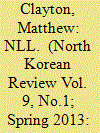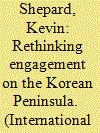| Srl | Item |
| 1 |
ID:
120388


|
|
|
| 2 |
ID:
108383


|
|
|
|
|
| Publication |
2011.
|
| Summary/Abstract |
The year 2010 witnessed an escalation of tensions on the Korean peninsula through two military crises. The rise in tensions can be explained by neorealism as a shifting distribution of power in the region and a small state preserving its national security. The paper argues that neorealism is not sufficient to explain the patterns and routines of crisis escalation and crisis resumption on the Korean peninsula and the North East Asian region. By focusing on the causes of conflicts neorealism fails to identify the consequences of these inter-state tensions for the evolution of an anarchical society of states in the North East Asian region. The paper provides an alternative interpretation of recent inter-Korean crisis escalation and crisis resolution in the East Asian region through the work of Hedley Bull.
|
|
|
|
|
|
|
|
|
|
|
|
|
|
|
|
| 3 |
ID:
092722


|
|
|
| 4 |
ID:
092933


|
|
|
|
|
| Publication |
2009.
|
| Summary/Abstract |
The Kaesong Industrial Complex (KIC), one of four special economic zones in North Korea, is an industrial park located in North Korea, just across the Demilitarized Zone (DMZ) from South Korea.2 The KIC stands out because, in recent years, the other three zones have become dysfunctional for all practical purposes. As of the end of 2008, 93 South Korean firms operated in the KIC, with a total of 38,931 North Korean workers along with 1,055 South Korean workers. The project was supposed to be carried out in three stages for years to come; the first stage was well under way and was expected to be completed in 2010. The complex was supposed to employ 100,000 North Korean workers and have 450 tenant companies by the end of 2010. However, such rosy projections about the KIC ended when North Korea cut the reconciliation dialogue with South Korea after its conservative president, Lee Myongbag, took office in February 2008. The purpose of this paper is to discuss a number of key points on the KIC in the context of inter-Korean economic cooperation, along with reasons for the U.S. interest in the KIC.
Special note: We completed this paper before North Korea and the United States began to take a series of new hardline actions against each other. However, the basic tone of this paper, an optimistic one, is likely to prevail in the long run because no one wants another Korean war and North Korea is unlikely to collapse any time soon.
|
|
|
|
|
|
|
|
|
|
|
|
|
|
|
|
| 5 |
ID:
138912


|
|
|
|
|
| Summary/Abstract |
In this article I assess the limits and potential of South Korea’s democracy as revealed by a review of political developments related to the Cheonan incident. I argue that the incident’s aftermath shows that South Korea’s democratic principles and procedures remain vulnerable to pressures generated by national security concerns, although this vulnerability was covered to a limited degree by an open public sphere and active civil society. Korea’s political functioning in terms of republican principles and procedural democracy was seriously tested as imperatives of national security created the “state of exception.” But civil society appropriated new technologies as well as old tactics to generate “public spheres” of deliberation. I suggest that Korean democracy during the Cheonan crisis reflects the resiliency and vulnerability of the “division system” in which South Korea’s politics is embedded.
|
|
|
|
|
|
|
|
|
|
|
|
|
|
|
|
| 6 |
ID:
120385


|
|
|
| 7 |
ID:
172462


|
|
|
|
|
| Summary/Abstract |
This was a year of transition in North Korea, as leader Kim Jong Un held firm to his strategic shift of putting “all efforts” into economic development in the face of ongoing international sanctions. Kim’s summit diplomacy with the US and South Korea stalled, while ties improved markedly with China and modestly with Russia. The US and South Korea resumed downsized joint military exercises and North Korea resumed short-range missile testing.
|
|
|
|
|
|
|
|
|
|
|
|
|
|
|
|
| 8 |
ID:
080126


|
|
|
| 9 |
ID:
097349


|
|
|
| 10 |
ID:
110794


|
|
|
|
|
| Publication |
2012.
|
| Summary/Abstract |
This paper discusses the national security challenges and policy dilemmas that
South Korea is predicted to face in the year 2012. North Korea is currently
engrossed in efforts for stabilization of its new regime led by Kim Jong Un. It is
expected that for the time being the two Koreas will seek signals to help facilitate
a shift in the bilateral situation amid the continuing tense situation. Meanwhile,
there remains a high possibility of recurrence of a crisis situation on the Korean
peninsula due to accumulated internal conflicts and the unproven leadership of
the North's new leader. Concerning the North's nuclear program, it is difficult to
expect it will be settled in the way intended at the time of launching the Six-Party
Talks. Under such circumstances, the international community's interest is
focused on what impact the new defense strategy adopted by the United States,
including the planned cuts in the U.S. defense budget over the next decade, will
have on the security situation in Northeast Asia. China's military buildup based
on its rapid economic development has become one of the main security concerns
for the countries in the region. The strategic dilemma associated with China's
military buildup looms large, particularly for South Korea, because the bilateral
relationship between the two Koreas overlaps with the ROK-U.S. alliance and the
relationship between South Korea and China. The best scenario would be if the
G-2, i.e. the United States and China, are willing to assume their share of responsibilities and capabilities in pending issues facing the international community, but
this could be wishful thinking. The importance of the ROK-U.S. alliance cannot be
overemphasized as long as U.S.-China relations remain one of "checking up on one
another" and confrontation, and there are continued threats from North Korea.
The South is certainly not alone in wishing to see China's development in diverse
sectors, i.e. raised GDP, the establishment of a competitive economic system, key
currency, global standards and military power, and increased responsibility and
capability for coping with security threats.
|
|
|
|
|
|
|
|
|
|
|
|
|
|
|
|
| 11 |
ID:
138915


|
|
|
|
|
| Summary/Abstract |
What changes has the Cheonan incident brought about in the Northeast Asian region? How and to what extent have those changes shifted as time goes by? I find that the Cheonan sinking has played a key role in deepening the ideological chasm in South Korea between conservatives and progressives. It has also become a serious obstacle to the improvement of South Korea–North Korea relations, and has been the catalyst for the emergence of a Cold War–like rivalry between the US–South Korea–Japan and the China–North Korea–Russia blocs. However, relations among neighboring countries in Northeast Asia have shifted over time, including significant improvement in China–Republic of Korea relations and worsening of relations between China and North Korea and South Korea and Japan.
|
|
|
|
|
|
|
|
|
|
|
|
|
|
|
|